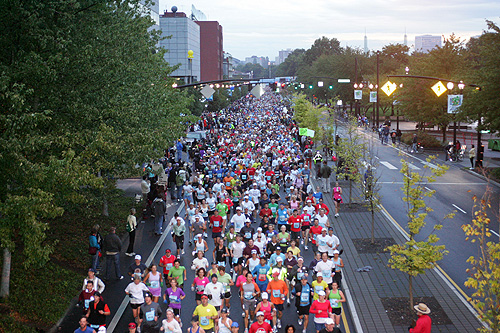 Oregon is getting pounded in the recession – pounded by the soles of runners clamoring to snag a spot in marathons, relays and races filling up around the state.
Oregon is getting pounded in the recession – pounded by the soles of runners clamoring to snag a spot in marathons, relays and races filling up around the state.
Oregon is getting pounded in the recession – pounded by the soles of runners clamoring to snag a spot in marathons, relays and races filling up around the state.
Running events are seeing record sales this year and new races are popping up all over. When times are tough it seems more people have opted for the cheap training regimen and treated a weekend race get-away as a vacation alternative. The popularity of the sport has already solidified Oregon and the Pacific Northwest as a running Mecca, and the economic impact is creating some big-time money for local communities.
 The Portland Marathon has sold out for the first time ever, and that’s just one of 174 running events in Oregon this year including triathlons, marathons, relays and shorter races. Les Smith, event director for the Portland Marathon estimates all the events bring in about $100 million collectively to the state of Oregon.
The Portland Marathon has sold out for the first time ever, and that’s just one of 174 running events in Oregon this year including triathlons, marathons, relays and shorter races. Les Smith, event director for the Portland Marathon estimates all the events bring in about $100 million collectively to the state of Oregon.
Anyone who crossed paths with one of the thousands of runners venturing the 197 miles from the top of Mt. Hood to the Pacific Ocean at Seaside last weekend saw the enthusiasm of the running community. This year marked the 29th annual OfficeMax Hood-to-Coast Relay, which is the largest event of its kind, and hosts thousands of runners and walkers from around the world.
The race has sold out for the past 12 years and had to turn down more participants than ever this year. The race is capped at 1,000 12-member teams, but this year nearly 2,500 teams applied. And it wasn’t just the runners who came out in droves. The party at the finish line in Seaside drew a crowd between 90,000 and 100,000, which matched the largest participation ever.
“We’ve talked to participants and the general mindset is that if your unemployed, and your personal life is in shambles then you want at least one great weekend to put everything else aside and have a good time,” said Robert Foote, the president and founder of the relay. Foote estimated the event brought in between $8 and $10 million to Clatsop County, according to the Seaside Signal.
Foote also credits the recession for boosting corporate relay sponsorship over the last two years. He said the bad economy has forced sponsors to move limited resources to the big events where they can be more visible.
This year’s Portland Marathon also thrived in the down economy. Swamped with applicants, organizers added a half-marathon, which also sold out months before the race, which will take place on October 10, 2010.
Smith said the demographic of race participants plays a big factor in the lucrative nature of the sport. He said the average family income for marathoners is $145,000, and the average marathoner earns an average of $92,000. That income level attracts high-end sponsors and can bring in hefty tourist dollars. An average of 2.5 people come to the race with each participant every year, staying in Oregon for an average of nearly 3 days, and bringing in an estimated $25 million dollars to the area, according to Smith.
“People who have the time to run are usually pretty well off,” said Smith. “The marathon has a high percentage of women which is even better in the market place because sponsors know women are the decision makers.”
The Portland Marathon is a non-profit and through the event some 800 charities raise between $2 and $3 million. The race also generates an additional $200,000 which was paid out last year to over 115 service clubs, school activities, sport teams and other nonprofits.
Several new for-profit races were created this year including the Eugene Women’s half marathon, which will happen this weekend. From a business stand-point marathons and half marathons generate the most profit because they only require one venue and the start and finish can be in one location. A triathlon or relay requires more planning, venues and strategy. Since the Hood-to-Coast is so expensive to organize, the event usually makes just enough to cover expenses, according to Foote. Marathons and half marathons can bring in much higher revenue.
Home to Nike, historic Hayward Field and the U.S. inspiration for long-distance running through the late Bill Bowerman, Oregon has a history in running that no one else can compete with, and a reputation people travel to experience.
“Oregon is the most hallowed ground of running,” said Smith. “We don’t have a lot of other distractions like major league football or baseball, but we have this running concept, and it’s been a financial boom.”
Photo credit to FlashPro
Jessica Hoch is an online reporter for Oregon Business magazine



